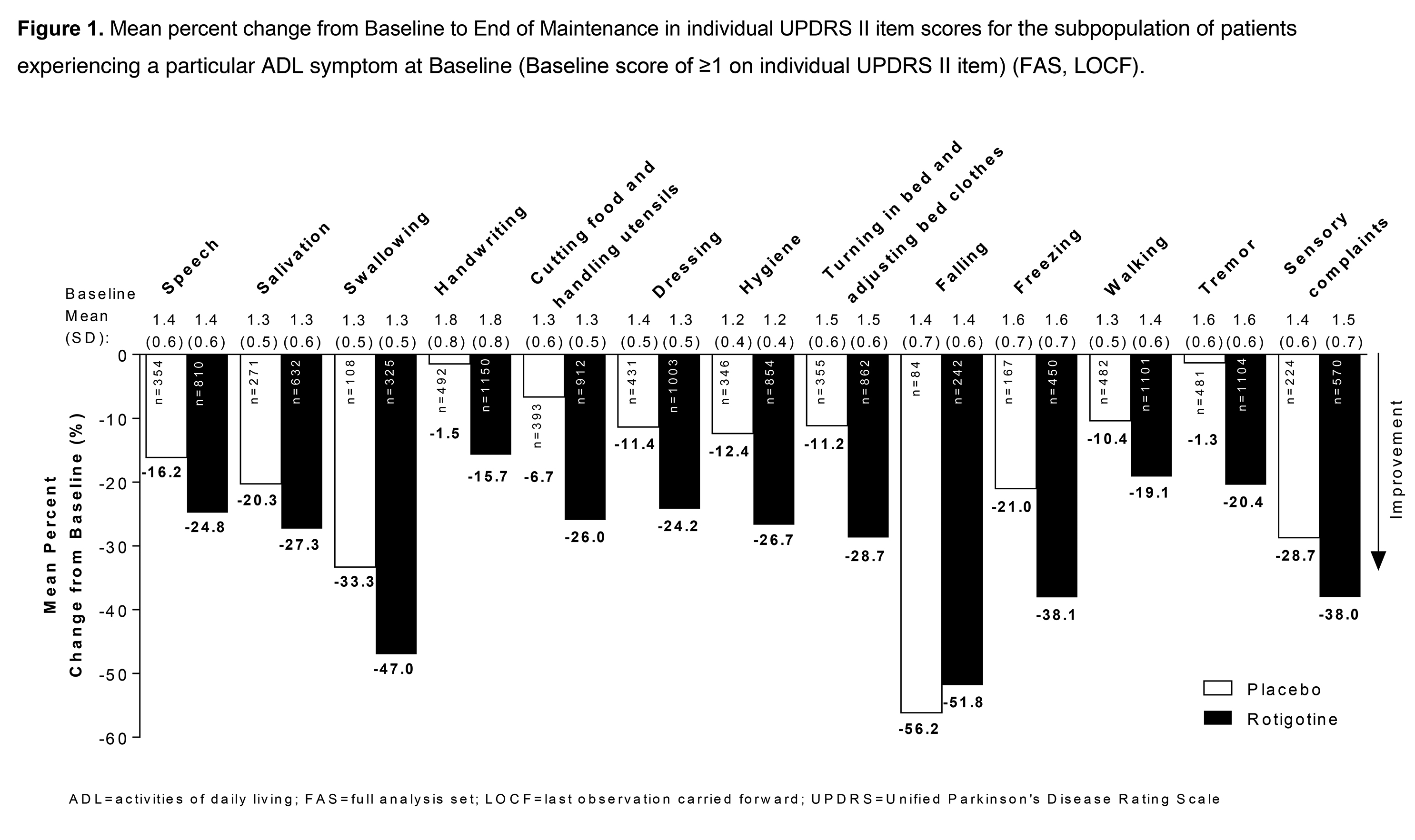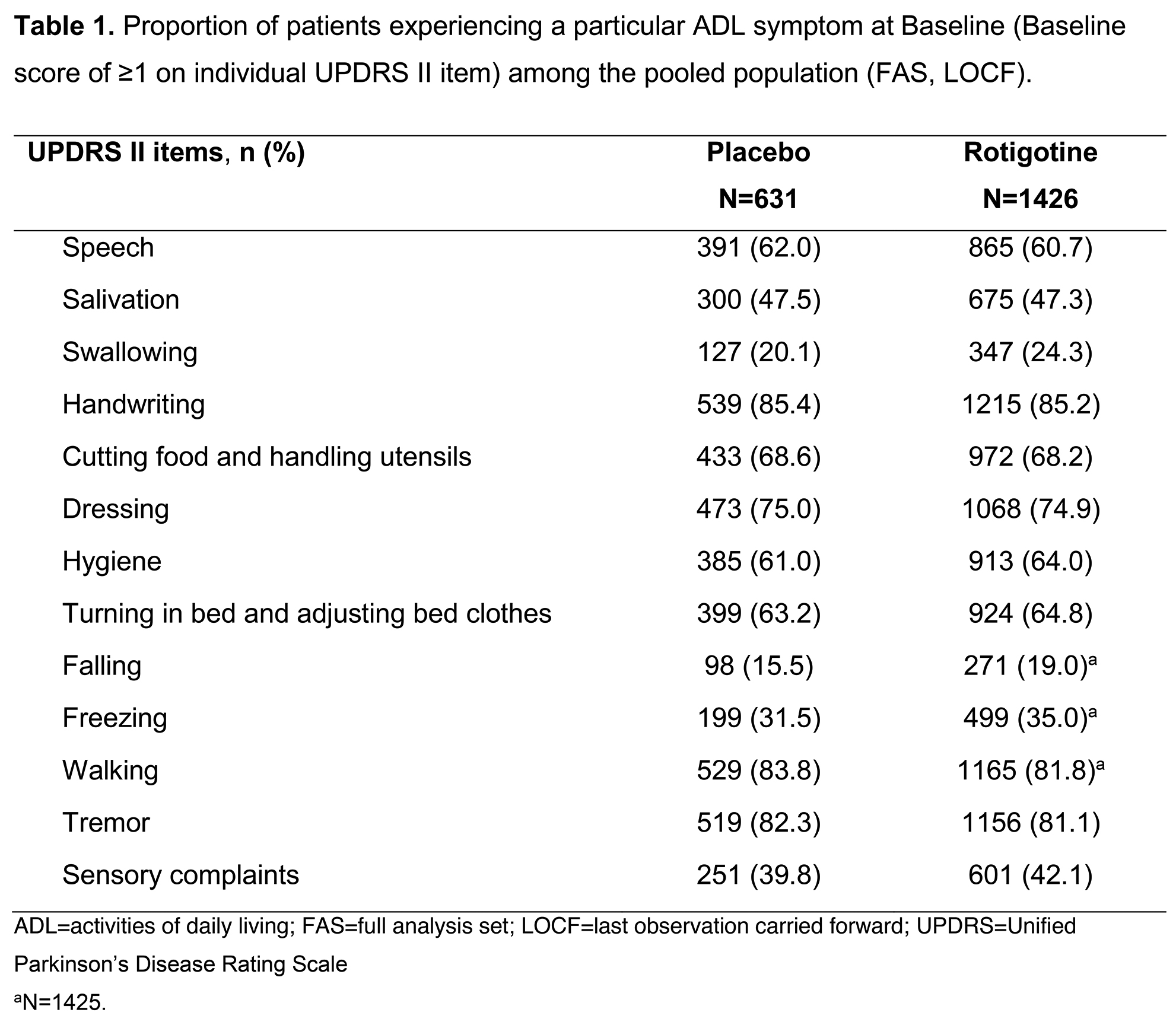Session Information
Date: Thursday, June 8, 2017
Session Title: Parkinson’s Disease: Clinical Trials, Pharmacology And Treatment
Session Time: 1:15pm-2:45pm
Location: Exhibit Hall C
Objective: The key aim was to assess the efficacy of rotigotine (RTG) transdermal patch on individual items of Unified Parkinson’s Disease Rating Scale (UPDRS) II in patients with Parkinson’s disease (PD).
Background: UPDRS is the most widely used rating scale in clinical research for PD. UPDRS II (13 items), completed by investigators based on patient input, measures treatment efficacy on activities of daily living (ADL). UPDRS is rarely used in clinical practice, so it may be challenging for physicians to relate the efficacy of PD medications in clinical studies (often reported as changes in UPDRS II total score) to impairments in individual ADL experienced by patients. Also, analyzing the change in individual UPDRS II items (rather than total score) may provide insights into functional benefits of RTG on specific ADL impairments.
Methods: Post-hoc analysis of pooled data from 6 placebo-controlled studies of RTG in early (SP506, SP512, SP513; not receiving levodopa; RTG ≤8mg/24h) or advanced PD (SP515 [NCT00244387], SP650, SP921 [NCT00522379]; inadequately controlled on levodopa; average 2.5h/day OFF time; RTG ≤16mg/24h), with maintenance ≥7 weeks. The proportion of patients among the pooled population experiencing various ADL impairments was assessed at Baseline (Baseline UPDRS II item score ≥1), and for this subpopulation, mean percent change in UPDRS II item score from Baseline to End of Maintenance was calculated. The analysis was repeated for 27 UPDRS III items (motor symptoms).
Results: Data were available for 2057 patients (RTG: 1426, placebo [PLB]: 631). The proportion of patients with a particular ADL impairment at Baseline varied from <20% (Falling) to >80% (Handwriting, Walking, Tremor) (Table 1). Mean percent change in UPDRS II item scores showed numerical improvement with RTG vs PLB in all items except Falling (Figure 1). Numerical improvement with RTG was observed in all UPDRS III items.
Conclusions: ADL impairments had varying frequencies in this large sample of PD patients. Scores on all UPDRS II items except Falling (which had relatively low Baseline frequency) numerically improved with RTG vs PLB, indicating consistency of response to RTG over many ADL impairments. Physicians may find these data useful when explaining to patients the expected effects of RTG on individual ADL impairments, especially those of most concern to patients.
Funding: UCB Pharma.
References: [table1]
[figure1]
To cite this abstract in AMA style:
M. Asgharnejad, H. Pesch, E. Dohin. Efficacy of rotigotine as measured by individual Unified Parkinson’s Disease Rating Scale II and III items: a post-hoc analysis [abstract]. Mov Disord. 2017; 32 (suppl 2). https://www.mdsabstracts.org/abstract/efficacy-of-rotigotine-as-measured-by-individual-unified-parkinsons-disease-rating-scale-ii-and-iii-items-a-post-hoc-analysis/. Accessed April 19, 2025.« Back to 2017 International Congress
MDS Abstracts - https://www.mdsabstracts.org/abstract/efficacy-of-rotigotine-as-measured-by-individual-unified-parkinsons-disease-rating-scale-ii-and-iii-items-a-post-hoc-analysis/


